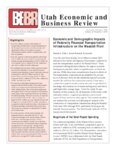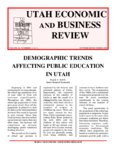TO
| Title | Date | Subject | Description | ||
|---|---|---|---|---|---|
| 76 |
 |
The coming boom in Utah's school age and college age populations: state and county scenarios | 2002-09 | Population analysts have for some time anticipated a significant increase in the school age population (5 through 17 years of age) of Utah beginning around 2004 and extending for at least a decade. At this point the question is not whether the boom will materialize, but rather, the exact timing, mag... | |
| 77 |
 |
Revised Utah population estimates for the 1990s | 2001-05 | Every 10 years, the U.S. Bureau of the Census conducts a population count. In the intervening years the Utah Population Es timates Committee (UPEC) annually prepares total resident population estimates for each of the 29 counties in the state. These estimates are based on methods that ut i l i z e s... | |
| 78 |
 |
Immigrants transform Utah: entering a new era of diversity | 2004-05 | Utah is generally perceived as an extremely homogeneous state whose population can trace its ancestry mostly to northern Europe. Listings for surnames like Hansen, Jensen, and Christensen do fill many pages in local telephone directories throughout the state. According to census counts, the minority... | |
| 79 |
 |
Fast-tracking Wasatch Front transit investments: economic and demographic impacts of a 2025 build-out | 2011 | Over the next 30 years, the Wasatch Front will significantly expand its transit network. Plans include the construction of an additional 25 miles of light rail, 76 miles of commuter rail, 227 miles of bus rapid transit, and 29 miles of mountain transportation rail line. These projects will be built ... | |
| 80 |
 |
Economic and demographic impacts of federally financed transportation infrastructure on the Wasatch Front | 2004-09 | Over the next three decades, $14.4 billion (constant 2004 dollars) of new transit and highway infrastructure is planned to meet the transportation needs of the Wasatch Front.1 These investments will significantly influence the region's economic development potential, relative competitiveness, and la... | |
| 81 |
 |
Demographic trends affecting public education in Utah | 2000-11 | Beginning in 2004 and continuing for at least a decade, the school age population (5 to 18 year olds) in Utah will increase significantly. Throughout the 1990s, the school age population in Utah grew more slowly than did the population in general so that its share in the total population declined. T... | |
| 82 |
 |
Utah's place in the macro-demographics of the U.S. in the 20th century | 2006-03 | Utah has evolved from an isolated rural state of fewer than 300,000 in 1900 to a mostly urban state of 2.5 million today. This paper is an attempt to place this population growth within the context of the broadest outlines of national population dynamics over the past century. The growth and regiona... | |
| 83 |
 |
Utah's demographic transformation: a view into the future | 2008 | Utah, along with the rest of the nation, is in the midst of an extraordinary demographic transformation which has far from run its course. The confluence of four major trends continues to dramatically reshape the size and composition of the national and state populations. These trends include the ar... | |
| 84 |
 |
Salt Lake County's distinctive demographics: implications for the future | 2006-11 | Salt Lake County is the economic, political, and cultural center of Utah. The county is currently home to nearly 40% of Utah residents and generates about half of all jobs in the state. It remains the most populous county, with a million of the state's 2.6 million residents,2 and its daytime populat... | |
| 85 |
 |
On trimodal particle size distributions in fly ash from pulverized-coal combustion | 2002 | trimordal particle size distributions; fly ash; pulverized-coal combustion; fine particles; PM | Combustion-generated fine particles, defined as those with aerodynamic diameters less than 2.5 lm, have come under increased regulatory scrutiny because of suspected links to adverse human health effects. Whereas classical theories regarding coal combustion suggest that mechanisms of ash vaporizatio... |
| 86 |
 |
Modeling the rich combustion of aliphatic hydrocarbons | 2000 | rich combustion; aliphatic hydrocarbons; kinetic mechanism; benzene formation; high-molecular-mass aromatic compounds | A new kinetic mechanism has been developed for the formation of benzene and high-molecular-mass aromatic compounds in rich flames of aliphatic hydrocarbons. The kinetic scheme emphasizes both the role of resonantly stabilized radicals in the growth of aromatics and the standard acetylene addition me... |
| 87 |
 |
Effect of ethanol on the chemical structure of the soot extractable material of an ethylene inverse diffusion flame | 2007 | Soot extractable material; Ethylene inversion diffusion flame; Aromatic fused rings; Neat flame; Chloroform-extractable material; Aliphatic component; Incomplete combustion; Fossil fuels; Ethanol; Soot; Emission; Soot particles; Polyaromatic hydrocarbons; Potential carcinogen | The effect of fuel-side ethanol addition on the chemical structure of the soot extractable material generated in an ethylene inverse diffusion flame was evaluated by means of average structural parameters. The results indicate that the ethanol effect on the aromatic components was more pronounced, w... |
| 88 |
 |
Problems frequently encountered in evaluating tar sand resources-the South Texas San Miguel deposit | 1987-11-02 | evaluating tar sand resources; tar sand resources; South Texas San Miguel deposit; OOIP; tar sand deposit | Good porosity and fluid saturation values are essential for accurately delineating original oil in place (OOIP) and evaluating the effectiveness of in situ recovery methods. Whereas the techniques for measuring and calculating these parameters from cores or downhole logs are well established for mos... |
| 89 |
 |
State space sensitivity to a prescribed probability density function shape in coal combustion system: Joint B-PDF versus clipped Gaussian PDF | 2000 | space sensitivity; coal combustion; b-PDF mixing model; three coal-off gas; pulverized-coal research furnace | The turbulent transport of three coal off-gas mixture fractions is coupled to a prescribed joint b-probability- density-function (b-PDF) mixing model. This physical transport and subgrid joint b-PDF mixing model is used to explore the incorporation of coal off-gas compositional disparities between t... |
| 90 |
 |
Modeling the vaporization of ash constituents in a coal-fired boiler | 2000 | vaporization of ash constituents; coal-fired boiler; minimizing harmful emissions; vaporization | Emissions of fine particulate and trace toxic metals are being subjected to increasing regulation. This paper addresses how the emission of these compounds can be influenced by changes in combustion conditions, particularly those selected to minimize NOx emissions. The vaporization and condensation ... |
| 91 |
 |
Petroliferous lithosomes in the Moenkopi Formation, southern Utah | 1977 | petroleum; stratigraphic study; southeastern and central Utah petroleum; Moenkopi Formation | Recent stratigraphic studies of the Triassic Moenkopi Formation suggest the possibility of important petroleum potential within the unit in southeastern and central Utah. Potential reservoir rocks include shoreline sandstone in the Black Dragon Member, carbonates in the Sinbad Limestone Member, and ... |
| 92 |
 |
Petroleum geology of the greater Red Wash Area, Uintah County, Utah | 1965-07 | oil and gas field; sandstone; petroleum geology | The Greater Red Wash area is the largest oil and gas field in the Uinta Basin. The Douglas Creek and Garden Gulch Members of the Green River Formation form a lacustrine delta in the area and yield hydrocarbons from a complex network of discrete sandstones. Each individual sandstone body forms its ow... |
| 93 |
 |
Relationships between composition and pulmonary toxicity of prototype particles from coal combustion and pyrolysis | 2009 | toxicity; prototype particles; coal combustion; pyrolysis; health effects; coal combustion fly-ash particles | The hypothesis that health effects associated with coal combustion fly-ash particles are exacerbated by the simultaneous presence of iron and soot was tested through two sets of experiments. The first set created prototype particles from complete and partial combustion, or oxygen free pyrolysis of a... |
| 94 |
 |
Federal control of carbon capture and storage | 2011-09 | carbon capture; carbon storage; coal; carbon sequestration | The United States has economically recoverable coal reserves of about 261 billion tons, which is in excess of a 250-year supply based on 2009 consumption rates. However, in the near future, the use of coal may be legally restricted because of concerns over the effects of its combustion on atmospheri... |
| 95 |
 |
Some possible applications of thermal recovery in Utah | 1965-11 | thermal recovery; applications of thermal recovery; oil reserves; bituminous sandstones; thermal project; bituminous oil sand | The bituminous sandstones of the Rocky Mountain region have significant reserves of oil. Production costs of the reserves must be reduced to be equal to or lower than the cost of crude oil produced by conventional methods. Three Utah deposits alone, Sunny side, Vernal (Asphalt Ridge) and Whiterocks ... |
| 96 |
 |
Tar sand research and development at the University of Utah | 1987 | tar sand research; tar sand development; hydrocarbon recovery; extensive tar sand deposits; in situ thermal production; bitumen; surface mining; hydrocarbon liquid | The recovery of hydrocarbon values from the extensive tar sand deposits of North America has generally been approached by one of two methods: in situ thermal production of the bitumen or of a bitumen-derived liquid or surface mining of the deposit followed by processing of the mined ore. In either a... |
| 97 |
 |
Organic petrology and rock-eval studies on oil shales from the Lower Carboniferous Rocky Brook Formation, Western Newfloundland | 1989-03 | organic petrology; rock-eval studies; oil shales; Lower Carboniferous Rocky Brook Formation; microscopy and geochemical analysis; rock-eval pyrolysis | Nine samples of oil shale from the Carboniferous Rocky Brook Formation along Rocky Brook in western Newfoundland were studied by incident light microscopy and geochemical analysis (Rock-Eval pyrolysis) to determine the maceral components, geochemical type, and maturation level of the kerogen fractio... |
| 98 |
 |
Oil sands: Resource, recovery, and industry | 1980 | oil sands; tar sand; bituminous sandstone; oil impregnated sandstone; bituminous sand; synthetic fuels | Oil sand, tar sand, bituminous sandstone, oil impregnated sandstone, or bituminous sand, by one name or another, have been identified in almost every country of the world and in almost every state in the United States. By far the largest and most commercially attractive deposits are in Alberta, Cana... |
| 99 |
 |
Oil shale and tar sands | 1976 | oil shale; tar sands; United States; alternative fuels; in situ processing; fractuing tests | To continue its growth or even its existence, the United States must find new energy supplies to replace the petroleum we are rapidly depleting. No fossil energy form can offer a long-range solution, but coal offers a mid-range solution. Unfortunately we're not geared to use it, and learning to appl... |
| 100 |
 |
Plant starts, Athabasca now yielding its hydrocarbons | 1967-10-23 | synthetic crude; Athabasca oil sands; crude; strip mining | First synthetic crude from the Athabasca oil sands region of northeastern Alberta will reach the Toledo, Ohio, refinery of Sun Oil Co. in November. It will be an excellent grade of crude - high in gravity, free of sulfur and nitrogen. But nonetheless, it will have a strange background. Instead of be... |
